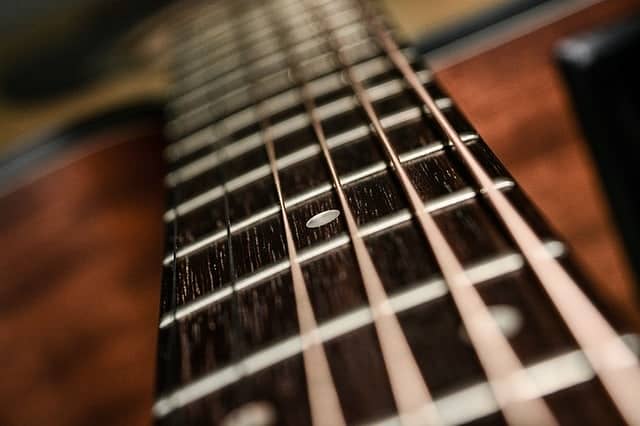
Bedding in a fresh set of strings will take a longer or shorter time depending on your guitar and how regularly you play it.
If you have an important gig or studio session coming soon? This post is everything you need to know about breaking in strings before any important guitar session.
So how long does it take to break in a fresh set of strings?
Electric guitar strings take the least time. Depending on usage, they roughly take 1-2 hours of constant playing to break in and settle allowing them to stabilize and stay in tune. Depending on usage, it may take 3-7 days to lose the ‘bright’ and ‘tinny’ sound associated with new strings.
What About Acoustics?

Steel Strings
When it comes to acoustic guitars, steel strings similarly only take a couple of hours of playing for the tuning stability to settle.
After a few days of playing they will also lose their ‘bright’ and ’crisp’ tone. Steel strings are known to age quicker than electric strings requiring more frequent string changes.
Nylon Strings
Nylon strings on a classical guitar, however, take the longest time to settle when it comes to tuning.
The average time for nylon strings is an average of 2-4 days for new strings to equilibrate depending on… how many hours go into playing, the amount of stretching, and the guitar’s construction.
The reason is that nylon is more elasticated than steel and copper wound nickel affects tuning stability. They are also under more tension than steel strings meaning they will need constant tuning to keep them in tune.
Nylon strings are also more sensitive to temperature and humidity which can affect stability.
Now you understand rough time periods for your guitar strings to seat correctly. You will also need to know what you can do to help them along…
How to Stretch Guitar Strings
When you have installed a new set of strings always remember to stretch them either by bending them or gently pulling them towards you in multiple positions across the fretboard.
New strings on any guitar will constantly be stretching yet they will require some manual stretching to help the process along.
There are two common ways you can stretch strings….
- Do aggressive bends in multiple positions across the fretboard on each string.
- Gently pull the strings upwards away from the fretboard towards yourself in multiple positions.
The reason why new strings go out of tune so frequently is that they have not been stretched in and are not used to the tension they are being subjected to.
I encourage you to read my related post does guitar string height affect tone? You can read this post here!
Changing Strings Before a Gig
It is useful to know that you should not risk changing strings too early when you need the guitar to perform optimally for a gig or studio session.
The reason is new strings take time to stretch into place risking an ‘off’ sounding guitar on the day due to a couple of strings drifting into a flatter pitch which annoyingly needs constant tuning correction.
Now you have an idea when strings equilibrate to your chosen guitar which I have mentioned above. So how long is a safe period for getting new strings broken in and to hold their tuning before a big gig or studio time?
- Electric guitar strings – 2-6 days before a gig/studio
- Steel – 2-3 days before a gig/studio
- Nylon – minimum of 6 days before a gig/studio
This is a rough guideline as this depends on how your guitar is set up, for example, bridge saddle, nut, neck relief, locking tuners, etc.
An electric with a tremolo device ‘locks’ the tuning into place. Whereas guitars without a locking device will need to be set up correctly for accurate tuning and pitch.
New String Sound
Some guitarists actually like the sound of new strings enjoying the ‘bright’ and ‘metallic’ sound for cutting and pristine clean tones for example.
For a metal player, however, the ‘metallic’ sound will not suit a tone with ultra-high saturated distortion, preferring a ‘darker’ and more ‘mellow’ sound once the strings have been played and worn in after a few days.
Personally, I prefer the sound of new strings on my guitar after 4-7 days of playing.
This is when the ‘bright’ sound has mellowed slightly but the strings have a good amount of ‘attack’ and ‘presence’ and become less rigid making string bends easier.
This is all subjective but every guitar player has their own preference for the ‘sweet spot’ sound when it comes to new strings.
As a side note, does guitar string brand matter? I wrote a post all about this topic walking you through whether the name on the strings is important in terms of string quality. You can view this post here!
How Often Should you Change Guitar Strings?
Many guitar players will give a different answer to this question as it all hinges on personal preference.
It is obvious that you should change a string when one of them breaks. Requiring you to change all of the strings instead of just the broken critter.
If your strings keep breaking frequently even if they are new, you must question the setup of the guitar ie: nut, bridge, break angle may be causing them to break besides being old.
The next reason would be to swap your strings when they sound dull, dead, and have lost brightness and presence. As strings age, they lose their tone and bright sound over time.
To recognize a dead string you will notice they look thinner and feel, gritty to the touch (especially with the high E string) this is because of grime, sweat, and corrosion.
Remember! “a clean guitar is a faster playing guitar.”
Because your ear has become ‘accustomed’ to the dull sound so you will certainly notice a difference when you add a new fresh set to your guitar. It will almost feel and play like a new
Another topic I have posted about which may interest you is do unpackaged strings have a shelf life?
My Recommendation
A rough guideline I like to use is having strings on my electric guitar for 1-2 months depending on usage. This is all personal preference however depending on how much you play and how quickly your strings corrode.
Personally, I will always change a dull-sounding set of strings before a gig to add brightness and more character to the tone.
I will always leave enough time however for the strings to seat to stay in tune to prevent any tuning issues.
Another thing to note is that a hot and humid venue can affect the tuning stability massively.
Meaning that I like to ensure that the strings have seated correctly before I play a live gig to give me the best tuning accuracy on the day of the gig.
What Affects Tuning Stability?
After you have re-strung your instrument and have enough time to settle. Yet your guitar is still having tuning issues. It’s not the strings themselves the guitar has a lot of elements that depict the tuning stability of a guitar.
- Bridge
- Nut
- Neck relief
- Angle of headstock
- Saddle
- String thickness
- Tuning Pegs
- Humidity
- Temperature
- How hard you play
- Re-string technique: when re-stringing an electric guitar for example… do you “top wrap” the strings or use any re-string method? “top wrapping” essentially clamps the string onto itself reducing the chances of it slipping and dropping out of tune when bending.
If you are concerned with tuning stability and curious about locking tuners? I have an awesome post detailing everything you need to know about locking tuners right here.
Related Questions
Do coated strings last longer than uncoated strings?
Coated strings have an element called ‘Teflon’ that seal the string from the elements such as grime, sweat, temperature making them last longer. This is useful on acoustic strings that tend to dull quicker than electric guitar strings.
Are locking tuners better for tuning stability?
Tuning pegs are one element to a host of other elements keeping a guitar in tune. Locking tuners have the benefit of ‘locking’ or clamping the strings together so they don’t slip with aggressive playing (string bends, heavy use of tremolo, heavy plucking attack).
Speaking of strings, my detailed guide explains what to do if you break one string on a new set of strings.
